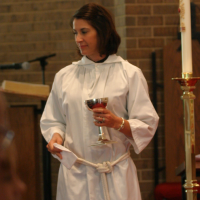this is what they got at the typical Novus Ordo Mass this past week-end:
A Visit to a local Parish
The New English Liturgy
A Cleaner Translation of a Protestantized Rite
By John Vennari
The First Sunday at Advent saw the mandatory introduction of the new English translation of the Novus Ordo into the nation’s parishes.
G.K. Chesterton once noted that the closer a man gets to sanity, the closer he gets to orthodoxy, that is, to the Catholic Church.
If the new translation is closer to accuracy of the original Latin, then it is closer to sanity, and thus at least closer, in this aspect, to a Catholic approach. The post-conciliar upheaval is of such colossal dimension that a fix in any of its broken structures can be viewed as a step in the right direction.
That being said, there is still a long way to go to restore sanity to parishes nationwide.
I visited a local parish church this morning for the purpose of observation. I wanted to see and hear the new translation, and take note of parishioners’ reactions.
The old pastor opened by announcing the imposition of the new translation, saying he has seen three responses to it.
The first: those who anticipate it with much enthusiasm. The second: those who view it with grudging acceptance. The third: those who simply ask “will it make the Mass longer?”
It is the first Novus Ordo Mass I’ve seen in a while, as I attend only the Latin Tridentine liturgy, so I came to the parish as an outsider.
One thing was immediately evident: the new translation may have somewhat improved the language, it has done nothing to improve the Novus Ordo atmosphere.
It is still the same New Mass with its banality, slovenliness and limp vestments. It is still a liturgy that appears to be drained of nobility and genuine reverence. It is still a liturgy that transforms the sanctuary into a high-traffic area of concelebrants, Eucharistic ministers, lay-lectors and music ministry.
Some of the most prominent changes in the English are as follows: The response to “The Lord be with you” is no longer, “And also with you”, but “And with your spirit.”
“Through my fault through my fault, through my most grievous fault” is returned to the Confiteor.
The Creed now speaks in the first person “I believe” instead of the communal “We believe”. Our Lord Jesus Christ is now proclaimed in the Creed as “consubstantial with the Father.”
Of course, the most notable change is the accurate words of the Consecration of the wine from what was “for you and for all” to “for you and for many.”
At Communion, the translation now says, “but say the word and my soul shall be healed.”
Outside of the various new translations, it is very much the same Novus Ordo we have seen for the past 40 years. There is no real sense that much has changed. This was especially evident when I saw the three Eucharistic ministers (one male, two female) receive Communion in the hand from the old pastor before they branched out to offer Communion under both kinds to the congregation. Many parishioners received in the hand. Two men walked up the center aisle to Communion side-by-side chatting with each other.
The music was a combination of traditional Advent hymns (O Come, O Come Emmanuel), and new numbers, such as a sappy, dead melody in 6/8 time I had never heard before. From what others tell me, the church I attended is typical of the parishes in Buffalo.
The old pastor closed the Mass by announcing from the podium two pieces of advice for us:
1) “Don’t criticize a man until you’ve walked a mile in his shoes. That way, he won’t hear your criticism from a mile away, and you’ll at least have his shoes.”
2) “The principle ‘If at first you don’t succeed, try again,’ does not apply to sky diving.”
Thanks, Father.
“A Striking Departure…”
As for parishioners’ reaction to the new translation, there wasn’t anything worth a mention. It was a sparsely populated morning Mass. I saw only a handful of people using the “Seasonal Missalette Worship Resource” supplied in the pews.
As for the new translation, it is simply a cleaner translation of a Protestantized rite – of the New Mass that was written with the help of six Protestant ministers.
Vatican Cardinals Ottaviani and Bacci, in their famous Letter to Pope Paul VI on June 5, 1969, (that accompanied the Critical Study) rightly warned that the New Mass “represents both in its whole and in its details a striking departure from the theology of the Mass as it was formulated by Session XXII of the Council of Trent. The ‘canons’ of the rite definitively fixed at that time erected an insurmountable barrier against any heresy which might attack the integrity of the Mystery.”[1]
The Critical Study of the Roman Theologians on the New Mass, otherwise known as the “Ottaviani Intervention”, spotlighted the many deficiencies inherent in the New Mass: Here are some of the defects they noted:
• A new definition of the Mass, as an ‘assembly’ rather than as a sacrifice offered to God;
• Omissions of elements emphasizing the Catholic teaching that the Mass makes satisfaction for sins, a teaching utter rejected by Protestants;
• The reduction of the priest’s role to a position approximating that of a Protestant Minister;
• Implicit denials of Christ’s Real Presence and the doctrine of Transubstantiation;
• The change of the Consecration from a sacramental action into a mere narrative retelling the story of the Last Supper;
• The fragmentation of the Church’s unity of belief through the introduction of countless options;
• Ambiguous language and equivocation through the rite which compromises the Church’s doctrine.[2]
Further:
• The Study said “It is obvious that the Novus Ordo obsessively emphasizes ‘supper’ and ‘memorial,’ instead of the unbloody renewal of the Sacrifice of the Cross.[3]
• The Study points out that in the New Mass, “the central role of the Real Presence has been suppressed”.[4]
• The Study accurately noted thatthe New Mass “has much to gladden the heart of the most modernist Protestant”.[5]
Mind you, as I have stressed many times throughout the years, this is a critique of the New Mass in the original Latin – in it’s “purest form” – as it was originally released by Paul VI in 1969. The other abuses and bad translations came later. The Critical Study didn’t even talk about these, though the Study could foresee these aberrations. Thus the new “more accurate” English translation of this New Mass, over which there is now much rejoicing, will serve little to repair the flawed Rite itself.
The New Mass – at its best – is not really a Catholic liturgy. It was not made for the worship of God that is His due, but was constructed for the sake of a modernist ecumenism that is contrary to reason, and that has always been condemned by the Catholic Church.[6] As early as 1933, St. Maximillion Kolbe rightly declared, “Ecumenism is the enemy of the Immaculata”[7] – the enemy of Our Lady herself!
The reason I never attend the New Mass has never been the question of validity: is the consecration valid or not? To me, that’s not the issue. The reason I only attend the Tridentine Mass and never the New is because the New Mass is not really a Catholic form of worship. It is at its best – in its purest form – a modernist and Protestantized liturgy constructed to serve the false gods of liberalism and ecumenism.
And it is the architects of the Mass who have told us this.
Archbishop Annibale Bugnini admitted, “We must strip from our Catholic prayers and from the Catholic liturgy everything which can be a shadow of a stumbling block for our separated brethren, that is, for the Protestants.”[8]
Likewise, Journalist Jean Guitton, a close friend and confident of Pope Paul VI, confirmed that its was the direct aim of the Pope to protestantize the liturgy. In a radio interview in the 1990s, Guitton said:
“The intention of Paul VI with regard to what is commonly called the Mass, was to reform the Catholic liturgy in such a way that it should almost coincide with the Protestant liturgy – but was is curious is that Paul VI did that to get as close as possible to the Protestant Lord’s supper… there was with Paul VI an ecumenical intention to remove, or at least to correct, or at least to relax, what was too catholic, in the traditional sense, and, I repeat, to get the Catholic Mass closer to the Calvinist Mass.”[9]
Thus we better understand why Cardinal Ottaviani and the Roman Theologians say in the Critical Study:
“It is obvious that the New Order of Mass has no intention of presenting the Faith taught by the Council of Trent. But it is to this Faith that the Catholic conscience is bound forever. Thus, the promulgation of the New Order of Mass, the true Catholic is faced with a tragic need to choose.”[10]
Many of us choose to have nothing to do with this New Mass because it is not truly a Catholic form of worship.
After observing the Novus Ordo Mass this morning, I shook off the dead weight of its proceedings and drove directly to attend the Latin Tridentine Mass at Our Lady of the Rosary in South Buffalo. Here was the sanity, orthodoxy and Catholicity of true worship. Here the true Mass was celebrated, a gift from God for which this day I was especially grateful.
Notes:
[1]The Ottaviani Intervention: Short Critical Study of the New Order of Mass, [Rockford: TAN, 1992], p. 27.
[2] Summery from The Ottaviani Intervention, p. 4.
[3]Ibid., p. 35.
[4] Ibid., p. 40.
[5] Ibid., p. 33.
[6] For a summary of the Catholic Church’s perennial teaching against modern ecumenism, see the magnificent encyclical of Pope Pius XI, Mortalium Animos, “On Fostering True Christian Unity”, January 6, 1928.
[7]The mission St. Maximilian entrusted to his Knights of the Immaculata was that of converting the whole world to the Catholic Church. He said, “Only until all schismatics and Protestants profess the Catholic Creed with conviction, when all Jews voluntarily ask for Holy Baptism – only then will the Immaculata have reached its goals.” “… In other words” Saint Maximilian insisted, “there is no greater enemy of the Immaculata and her Knighthood than today’s ecumenism, which every Knight must not only fight against, but also neutralize through diametrically opposed action and ultimately destroy.We must realize the goal of the Militia Immaculata as quickly as possible: that is, to conquer the whole world, and every individual soul which exists today or will exist until the end of the world, for the Immaculata, and through her for the Most Sacred Heart of Jesus.” From Rycerz Niopokalenz, 4 (1922), p. 78. And Entry of Diary dated April 23, 1933. Cited from The Immaculata Our Ideal, Father Karl Stehlin [Warsaw: Te Deum, 2005], p.3
[8]L’Osservatore Romano, March 19, 1965.
[9] Quoted from Michael McGrade, “Redemptionis Sacramentum, DOA, RIP”, Christian Order, August, September, 2004 (emphasis added).
[10]The Ottaviani Intervention, p. 53.




